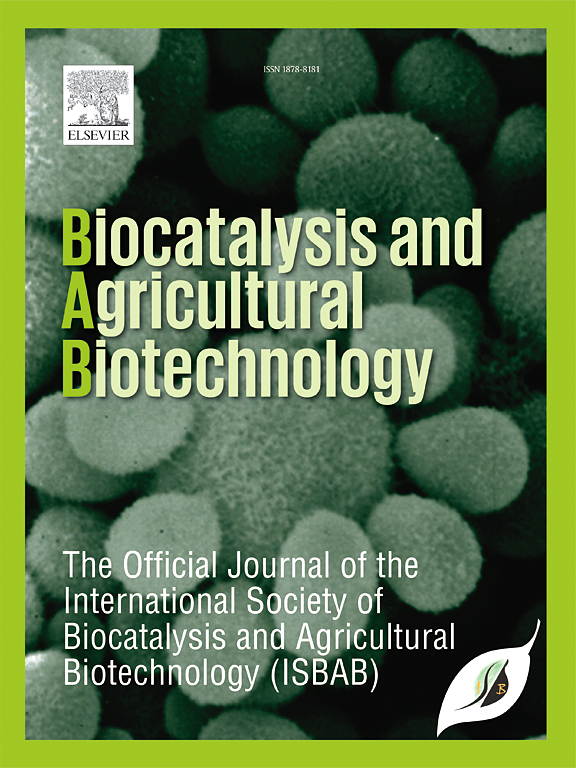Harnessing microbial potential: Exploiting heavy oil-laden soil microbiota for sustainable production of high-yield rhamnolipids from waste cooking oil
IF 3.8
Q2 BIOTECHNOLOGY & APPLIED MICROBIOLOGY
引用次数: 0
Abstract
Oil polluted soil microbiota plays an important role in the production of biosurfactants. In comparison to synthetic surfactants, biosurfactants offer unique advantages, such as lower toxicity, biodegradability, selectivity, and effectiveness under unpleasant conditions. Despite these benefits, the widespread use of biosurfactants is limited by enormous production costs. To address this challenge, this study aimed to explore the adoption of waste cooking for rhamnolipids production. Two prominent bacterial strains: Kosakonia cowanni and Acinetobacter colcoaceticus, were obtained from heavy oil-laden soil samples, and further demonstrated their capability for rhamnolipids production from waste cooking oil (Acinetobacter colcoaceticus: 0.51 g/L, Kosakonia cowanii: 0.39 g/L). The biosurfactants obtained were characterized through TLC, FTIR, and H NMR to confirm their rhamnolipid identities as mono-rhamnolipids. The findings in our study emphasizes the potential of cost-effective production of rhamnolipids that possess interesting biotechnological features through the synergy of oil-polluted environments and waste cooking oil. This study contributes significantly to the development of sustainable rhamnolipid production using non-pathogenic strains. By harnessing these microorganisms, we advance towards addressing critical environmental challenges, such as heavy metal contamination in water. This research aligns with broader sustainability goals, including clean water and sanitation.
利用微生物潜力:利用含重油的土壤微生物群,从废弃食用油中可持续地生产高产鼠李糖脂
受石油污染的土壤微生物群在生物表面活性剂的生产中发挥着重要作用。与合成表面活性剂相比,生物表面活性剂具有独特的优势,如毒性低、可生物降解、选择性强、在不愉快的条件下也能发挥作用。尽管有这些优点,但生物表面活性剂的广泛使用受到巨大生产成本的限制。为应对这一挑战,本研究旨在探索采用废弃烹饪生产鼠李糖脂的方法。两种著名的细菌菌株研究人员从含有重油的土壤样本中获得了牛角科萨孔菌和大肠埃希氏杆菌,并进一步证明了它们利用废弃食用油生产鼠李糖脂的能力(大肠埃希氏杆菌:0.51 克/升,牛角科萨孔菌:0.39 克/升)。我们通过 TLC、傅立叶变换红外光谱和 H NMR 对所获得的生物表面活性剂进行了表征,以确认其鼠李糖脂为单鼠李糖脂。我们的研究结果强调了通过油污染环境和废弃食用油的协同作用,以具有成本效益的方式生产鼠李糖脂的潜力,这些鼠李糖脂具有有趣的生物技术特征。这项研究为利用非致病菌株开发可持续鼠李糖脂生产做出了重大贡献。通过利用这些微生物,我们在应对重金属污染等关键环境挑战方面取得了进展。这项研究符合更广泛的可持续发展目标,包括清洁水和卫生设施。
本文章由计算机程序翻译,如有差异,请以英文原文为准。
求助全文
约1分钟内获得全文
求助全文
来源期刊

Biocatalysis and agricultural biotechnology
Agricultural and Biological Sciences-Agronomy and Crop Science
CiteScore
7.70
自引率
2.50%
发文量
308
审稿时长
48 days
期刊介绍:
Biocatalysis and Agricultural Biotechnology is the official journal of the International Society of Biocatalysis and Agricultural Biotechnology (ISBAB). The journal publishes high quality articles especially in the science and technology of biocatalysis, bioprocesses, agricultural biotechnology, biomedical biotechnology, and, if appropriate, from other related areas of biotechnology. The journal will publish peer-reviewed basic and applied research papers, authoritative reviews, and feature articles. The scope of the journal encompasses the research, industrial, and commercial aspects of biotechnology, including the areas of: biocatalysis; bioprocesses; food and agriculture; genetic engineering; molecular biology; healthcare and pharmaceuticals; biofuels; genomics; nanotechnology; environment and biodiversity; and bioremediation.
 求助内容:
求助内容: 应助结果提醒方式:
应助结果提醒方式:


